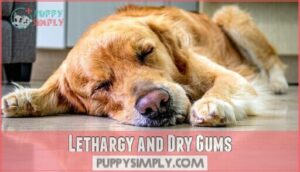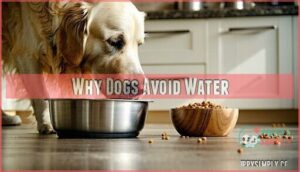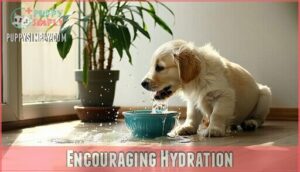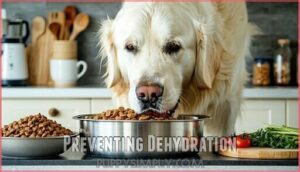This site is supported by our readers. We may earn a commission, at no cost to you, if you purchase through links.
 If your dog isn’t drinking water but is still eating, it might be stressed, in mild pain, or even picky about the water itself—yes, some dogs are surprisingly particular.
If your dog isn’t drinking water but is still eating, it might be stressed, in mild pain, or even picky about the water itself—yes, some dogs are surprisingly particular.
A dirty water bowl, odd-tasting water, or recent changes at home can turn them off. Health issues like mouth sores, kidney trouble, or a mild tummy upset could also play a role.
Watch for signs like lethargy, dry gums, or excessive panting—these could hint at dehydration. Encouraging hydration with flavorful tricks, like adding a splash of broth to water, might help.
Sometimes, though, it’s best to get a vet’s advice to rule out anything serious.
Table Of Contents
- Key Takeaways
- Dog Dehydration Signs
- Factors Affecting Water Intake
- Why Dogs Avoid Water
- Encouraging Hydration
- Veterinary Care and Monitoring
- Preventing Dehydration
- Frequently Asked Questions (FAQs)
- Why does my dog not eat and drink water?
- What does it mean if your pet drinks too much water?
- Why is my dog not drinking?
- How long can a dog drink water without food?
- Why is my dog eating but not drinking water?
- How do you hydrate a dog that won’t drink water?
- How long is it okay for a dog to not drink water?
- What are the signs of dehydration in dogs?
- What are the symptoms of heatstroke in dogs?
- What immediate actions should I take if my dog is suffering from heatstroke?
- Conclusion
Key Takeaways
- Check if stress, dental pain, dirty water bowls, or odd water taste are causing the issue, and address any discovered problems.
- Watch for dehydration signs like dry gums, lethargy, and sunken eyes, and act quickly to prevent serious health risks.
- Encourage hydration by flavoring water with low-sodium broth, offering ice cubes, or providing multiple clean and accessible water sources.
- Visit a vet if the behavior continues, dehydration signs worsen, or underlying health issues like kidney disease or infections are suspected.
Dog Dehydration Signs
You’ll notice several warning signs when your dog is dehydrated but still eating their food.
Several signs like dry gums and sunken eyes may indicate your dog is dehydrated despite eating normally—act quickly to rehydrate.
Dry gums, sunken eyes, and reduced skin elasticity are clear indicators that your dog needs immediate hydration attention, even if their appetite remains normal.
Lethargy and Dry Gums
One of the earliest signs of canine dehydration is lethargy paired with dry gums.
If your dog’s eating but not drinking, check their gums – they should be moist and pink, not tacky or pale.
Lethargy causes include dehydration severity affecting energy levels.
While some dogs naturally rest more, unusual tiredness combined with dry gum hydration warrants immediate veterinary assessment, especially if they’re eating only solid food.
A key indicator is disinterest in activities, which can be a sign of dehydration severity and requires immediate veterinary assessment.
Excessive Panting and Loss of Skin Elasticity
Beyond those dry gums, your dog shows other concerning dehydration signs through excessive panting and skin elasticity changes.
When dehydrated, dogs pant more as their body struggles to cool down. The skin turgor test is telling—pinch your dog’s skin between the shoulder blades; it should spring back immediately.
If it doesn’t, dehydration severity might be significant. * Excessive panting often signals both dehydration and potential heatstroke signs.
- Skin elasticity factors decline as water content decreases in tissue.
- Dehydrated dogs may show "skin tenting" where pinched skin remains elevated longer.
Sunken Eyes and Loss of Appetite
Sunken eyes in your dog are a serious red flag that shouldn’t be ignored.
When dehydration becomes severe, the fluid cushioning the eyes diminishes, causing that unsettling "sunken" appearance.
This often coincides with a reduced appetite, creating a concerning cycle.
| Dehydration Severity | Signs to Watch | Action Needed |
|---|---|---|
| Mild | Slightly dry gums | Offer fresh water |
| Moderate | Skin tenting, lethargy | Call vet within 24 hours |
| Severe | Sunken eyes, no appetite | Emergency vet visit |
| Critical | Collapse, extreme weakness | Immediate hospitalization |
The table outlines the dehydration severity levels, from mild to critical, along with the signs to watch for and the necessary actions to take, including an emergency vet visit for severe cases and immediate hospitalization for critical ones.
Factors Affecting Water Intake
Your dog’s water intake can be affected by multiple factors including environmental changes, stress, health issues, and dietary habits that aren’t immediately obvious.
Understanding these influences will help you address the concerning situation when your dog continues eating but refuses to drink adequate water.
Environmental Changes
After identifying dehydration signs in your dog, it’s essential to consider how environmental changes might affect water intake.
Dogs thrive on consistency, and disruptions to their routine can substantially impact drinking habits.
- New environments during travel can trigger anxiety, making your dog hesitant to drink from unfamiliar sources
- Household changes like moving furniture or introducing new pets can create stress
- Seasonal temperature shifts may alter your dog’s hydration needs without you noticing
Behavioral Issues
While environmental factors play a role, your dog’s psychological state substantially impacts their water intake.
Dogs experiencing anxiety or stress often show reduced interest in drinking. Routine changes can trigger water aversion, as can separation anxiety when you’re away.
Your furry friend might associate the water bowl with negative experiences or feel unsafe while drinking. Establishing consistent patterns and using positive reinforcement techniques can help overcome these behavioral issues and encourage proper hydration, leading to better overall health through proper hydration.
Health Concerns
Despite eating normally, your dog’s refusal to drink water could signal underlying medical conditions.
Kidney disease, urinary infections, and gastrointestinal issues often affect hydration patterns, and certain medications can also decrease thirst as a side effect.
When your dog’s not drinking, these health concerns require immediate veterinary consultation, as dehydration can quickly become serious, especially if underlying illnesses are present, and it’s crucial to address the situation promptly to prevent further complications due to underlying medical conditions.
Don’t delay seeking professional help if this behavior persists.
Dietary Factors
While health issues can affect your dog’s water intake, what you feed your furry friend plays an equally important role.
Your dog’s diet directly impacts their hydration levels.
- Dry food contains only 10-12% moisture compared to wet food’s 70-80%
- Adding broth to meals increases both flavor and hydration
- Cucumber and watermelon provide natural hydration sources
- Food moisture content decreases the need for separate water intake
- Switching between dry and wet food affects overall hydration needs
Why Dogs Avoid Water
Your dog’s reluctance to drink water while still eating normally often signals an underlying issue that needs your attention.
A dog’s refusal to drink water, despite eating, often reveals hidden concerns that demand prompt attention to prevent serious health risks.
You’ll need to identify whether it’s caused by anxiety, dental pain, or even something as simple as a dirty water bowl to help your furry friend stay properly hydrated.
Anxiety and Stress
Your dog may clam up and refuse water when anxiety takes over.
Separation anxiety, routine disruptions, and new environments often trigger stress responses that affect drinking habits.
Dogs thrive on consistency, so travel stress or household changes can cause them to skip hydration while still eating.
Watch for attachment issues during phases – your pet’s reluctance to drink might be their way of expressing discomfort with unfamiliar situations, related to separation anxiety.
Pain and Discomfort
While anxiety can affect your dog’s drinking habits, physical pain often plays a hidden role too.
Your furry friend may be eating but avoiding water due to dental pain, mouth sores, or throat discomfort that makes swallowing painful.
Joint discomfort might limit trips to the water bowl, while internal issues like bladder infections can also cause your dog not drinking despite eating normally.
Post-surgery pain or injury pain frequently impacts hydration before appetite.
Bowl Cleanliness and Water Taste
Just as physical discomfort can deter drinking, your dog’s water bowl might be the culprit behind their reluctance.
Dogs have sensitive taste preferences that humans often overlook, and certain factors can significantly impact their willingness to drink.
Plastic bowls can harbor bacteria despite regular rinsing, while certain water sources contain minerals your pet detects but you can’t.
Try switching bowl material, cleaning frequency, and water temperature if your dog’s not drinking water but eating normally, and consider using BPA-free plastic to guarantee safer hydration.
Encouraging Hydration
You can restore your dog’s interest in drinking water through several practical strategies that address the underlying causes of hydration resistance.
When your dog maintains proper fluid intake, you’ll prevent serious health issues while supporting essential bodily functions like digestion, circulation, and temperature regulation.
Multiple Water Sources
Having multiple water sources throughout your home can substantially increase your dog’s water intake.
Place bowls in different locations where your dog spends time – near their bed, food bowl, and outdoor areas.
Some dogs dislike shared bowls, so provide individual water sources if you have multiple pets.
Consider bowl placement carefully – elevated bowls benefit larger breeds or those with joint issues.
Many owners find that raised feeders help with digestion.
Outdoor access to fresh water is equally important, especially during warmer months when dog hydration becomes critical, and having fresh water available is essential.
Flavoring Water and Using Fountains
Picky drinkers can be enticed with flavor enhancements when you notice your dog not drinking water but eating normally.
Try adding a splash of low-sodium chicken broth for broth benefits that mask water taste or smell.
Pet water fountains offer moving water that appeals to canine taste preferences, while maintaining proper fountain hygiene.
Frozen treats provide ice alternatives without diluting flavors—just monitor flavor concerns with veterinary guidance if consumption doesn’t improve.
To further encourage hydration, consider that filtered water is preferable for cleaner hydration, and note the importance of proper fountain hygiene and veterinary guidance for the best results with frozen treats.
Consistent Water Routine
Building a routine helps when your dog won’t drink. Scheduled water breaks after play or meals keep hydration steady.
Post-meal hydration and bedtime water access guarantee consistent bowl placement works like clockwork for dog water intake. Dogs thrive on predictability, so stick to a pattern.
If your dog’s eating only but avoiding water, a stable routine can prevent dehydration, and maintaining a schedule is crucial for consistent bowl placement.
Rewarding Hydration Behavior
After setting a consistent water routine, focus on rewarding hydration behavior.
Use treat timing and verbal praise to create a positive association with drinking. Try hydration games like dropping ice cubes into the bowl or offering water-rich treats.
Consistent reinforcement keeps your dog interested. If your dog’s appetite is good but they’re not drinking, these steps can encourage effective hydration by making it a positive experience.
Veterinary Care and Monitoring
If your dog isn’t drinking water, a vet visit should be your first step to rule out serious issues.
They can perform tests, provide treatments, and guide you on keeping your pet hydrated and healthy.
Signs of Dehydration
Spotting dehydration in dogs is essential.
Lethargy signs, dry gum moisture, and reduced skin elasticity signal trouble.
Excessive panting frequency or appetite loss may also hint at a dog dehydrated.
If your dog’s eating only but not drinking, check for sunken eyes or dry gums.
These dehydration clues can escalate quickly, so don’t ignore these dog illness signs—act promptly to address lethargy signs, dry gum moisture, and reduced skin elasticity.
Diagnostic Tests and Treatment
When your dog’s not drinking but eating, diagnostic tests are key.
Vets may recommend:
- Blood work to check organ health.
- Urinalysis for kidney or urinary issues.
- Diagnostic imaging like X-rays or ultrasounds.
- Fluid therapy to rehydrate.
- Dietary adjustments or medications for underlying problems.
Quick action and veterinary advice can make all the difference!
Emergency Care for Severe Dehydration
If your dog shows severe dehydration signs, like sunken eyes or lethargy, seek emergency care immediately.
Rapid rehydration through IV fluids or subcutaneous fluids restores electrolyte balance and prevents organ failure. Hospitalization may be necessary for fluid therapy and monitoring.
| Symptom | Treatment | Goal |
|---|---|---|
| Sunken Eyes | IV Fluids | Rapid Rehydration |
| Dry Gums | Subcutaneous Fluids | Electrolyte Balance |
| Lethargy | Hospitalization | Prevent Organ Failure |
The table outlines specific symptoms and their corresponding treatments, aiming for rapid rehydration and maintaining electrolyte balance to support the dog’s recovery.
Preventing Dehydration
Keeping your dog hydrated is essential to their health, especially if they’re not drinking enough water.
By providing clean water, moisture-rich foods, and monitoring their habits, you can help prevent dehydration before it becomes a serious issue.
Providing Clean Water and Moisture-Rich Food
Keep bowls spotless to boost water bowl hygiene.
Wet food benefits hydration, so mix it in or pour water over dry kibble. Vegetables like cucumber or watermelon are great hydration sources.
Broth flavoring tips: add low-sodium broth for taste. Ice cube treats work too.
Consider investing in a self-filling waterer to guarantee constant access. If your dog won’t drink but eats, these tricks help to improve hydration!
Reducing Stress and Anxiety
When life shifts—new pets, household changes, or travel stress—it can unsettle your dog.
Creating safe spaces and sticking to routine consistency helps reduce anxiety. Calming techniques like soft music or positive reinforcement encourage relaxation.
For severe cases like separation anxiety, consider asking your vet about anxiety medication. A vet might suggest SSRI and antidepressants to help manage the issue.
Address environmental conditions to keep your furry friend comfortable and hydrated.
Monitoring Water Intake and Activity Levels
A consistent monitoring routine guarantees your dog’s water intake matches its activity levels, keeping hydration schedule steady.
Pay attention to intake-output balance; track drinking habits and energy levels daily.
Environmental adjustments, like placing bowls in cool spots, help.
If your dog’s eating only, not drinking, behavior monitoring reveals clues about subtle changes affecting hydration and overall health.
Consulting a Veterinarian for Guidance
When your dog’s not drinking but still eating, a vet visit can clear up concerns.
Veterinary care helps uncover underlying illnesses and guides treatment. Don’t ignore potential dehydration risks—early action matters.
- Vet consultation importance: Rule out serious issues.
- Diagnostic testing options: Blood work, urinalysis, imaging.
- Treatment plan adherence: Follow vet instructions.
- Monitoring at home: Watch water intake closely.
Frequently Asked Questions (FAQs)
Why does my dog not eat and drink water?
It’s puzzling when your dog skips meals and avoids water.
Stress, dental pain, or underlying illnesses like kidney issues could be culprits.
Monitor closely, and if this continues, a vet visit is essential.
What does it mean if your pet drinks too much water?
If your pet drinks too much water, it could signal conditions like diabetes, kidney disease, or hormonal imbalances.
Always monitor their drinking habits and consult your vet if you notice excessive thirst or unusual behavior.
Why is my dog not drinking?
Dogs can survive three days without water, but reduced drinking can signal dental pain, anxiety, or illness.
Check for clean bowls, fresh water, and signs of discomfort.
If unsure, consult your vet immediately.
How long can a dog drink water without food?
Your dog can survive about 3-5 days drinking water without food, but it’s not ideal.
While water is critical, prolonged fasting harms their health.
Make certain they’re eating soon or consult a vet.
Why is my dog eating but not drinking water?
Sometimes, it’s like your dog’s giving water the cold shoulder.
Stress, dental pain, or even a dirty bowl can be culprits.
Check for these issues, and consult a vet if the behavior continues.
How do you hydrate a dog that won’t drink water?
Try enticing your pup with flavored water, like a little low-sodium chicken broth.
Offer ice cubes as treats, or mix water into wet food.
A vet visit’s key if hydration remains a struggle, consider it a key step to ensure your pup’s health.
How long is it okay for a dog to not drink water?
Think of water as your dog’s lifeline.
A healthy dog shouldn’t go without water for more than 24-48 hours.
Beyond that, dehydration risks spike, so seek veterinary help if water avoidance continues.
What are the signs of dehydration in dogs?
Watch for dry gums, sunken eyes, excessive panting, loss of skin elasticity, and lethargy—classic signs your dog’s dehydrated.
Gently pinch their skin; if it doesn’t snap back quickly, they may need immediate hydration.
What are the symptoms of heatstroke in dogs?
Heatstroke symptoms in dogs include heavy panting, drooling, bright red gums, vomiting, diarrhea, confusion, rapid heartbeat, and collapse.
Their paws can feel hot, and they may struggle to stand.
Immediate cooling and vet care are critical.
What immediate actions should I take if my dog is suffering from heatstroke?
Like a race against time, move your dog to a cool spot, offer small sips of water, and apply cool, damp towels to their body.
Immediately contact your vet for further guidance and care.
Conclusion
Don’t worry if your dog isn’t drinking water but eating—it’s often fixable with a few tweaks.
Check their environment, water bowl, and overall behavior for clues. Sometimes stress, mild pain, or even a preference for fresh or flavored water is the issue.
If dehydration signs like dry gums or lethargy appear, act quickly. Encourage hydration with tricks like broth or fountains, but consult a vet if needed.
Staying observant guarantees your pup stays happy and healthy!

















